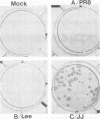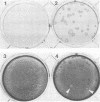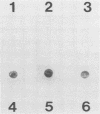Abstract
A variety of chemically defined compounds were tested to characterize the substrate specificity of the influenza C virus esterase and to determine whether a substrate could be found that would be useful in an assay to detect the virus. Two new substrates, alpha-naphthyl acetate and alpha-naphthyl propionate, were identified; alpha-naphthyl acetate was employed to develop an assay specific for influenza type C virus in MDCK cells. The assay was sufficiently sensitive to detect esterase activity in a single cell and distinguished influenza C virus infections from those of types A and B viruses. Infected cells could be detected as early as 8 h postinfection, with maximal enzyme detection occurring at 24 h. Assay of influenza C virus in the chorioallantoic or amniotic fluid of infected eggs was performed by applying fluids directly onto nitrocellulose strips and then incubating with alpha-naphthyl acetate. Both the cellular and nitrocellulose-bound assays are rapid, inexpensive, and easy to perform, offering advantages for use in clinical laboratories.
Full text
PDF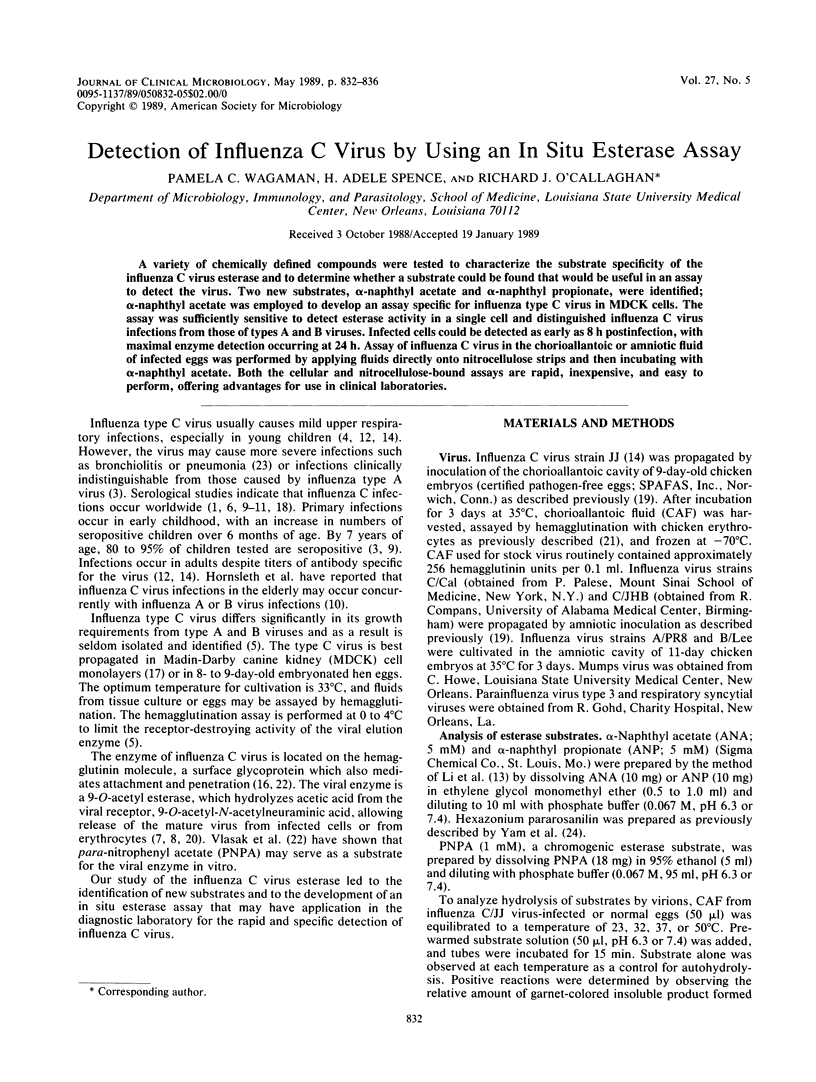
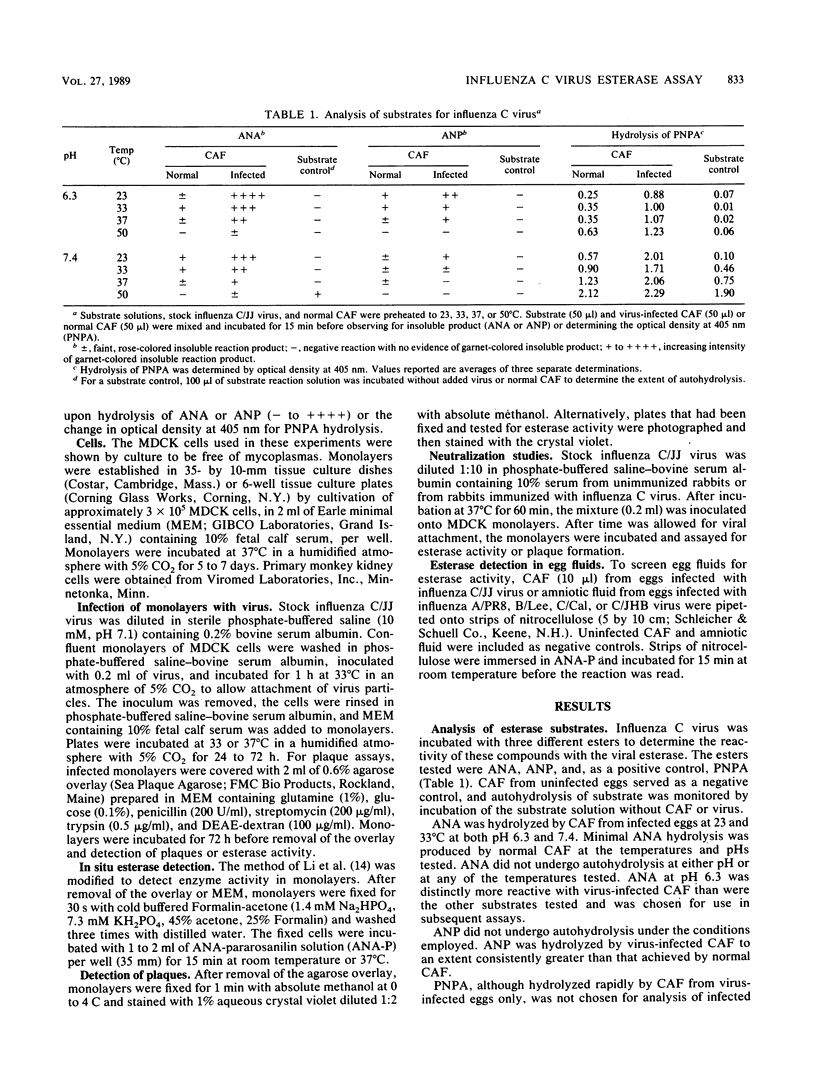
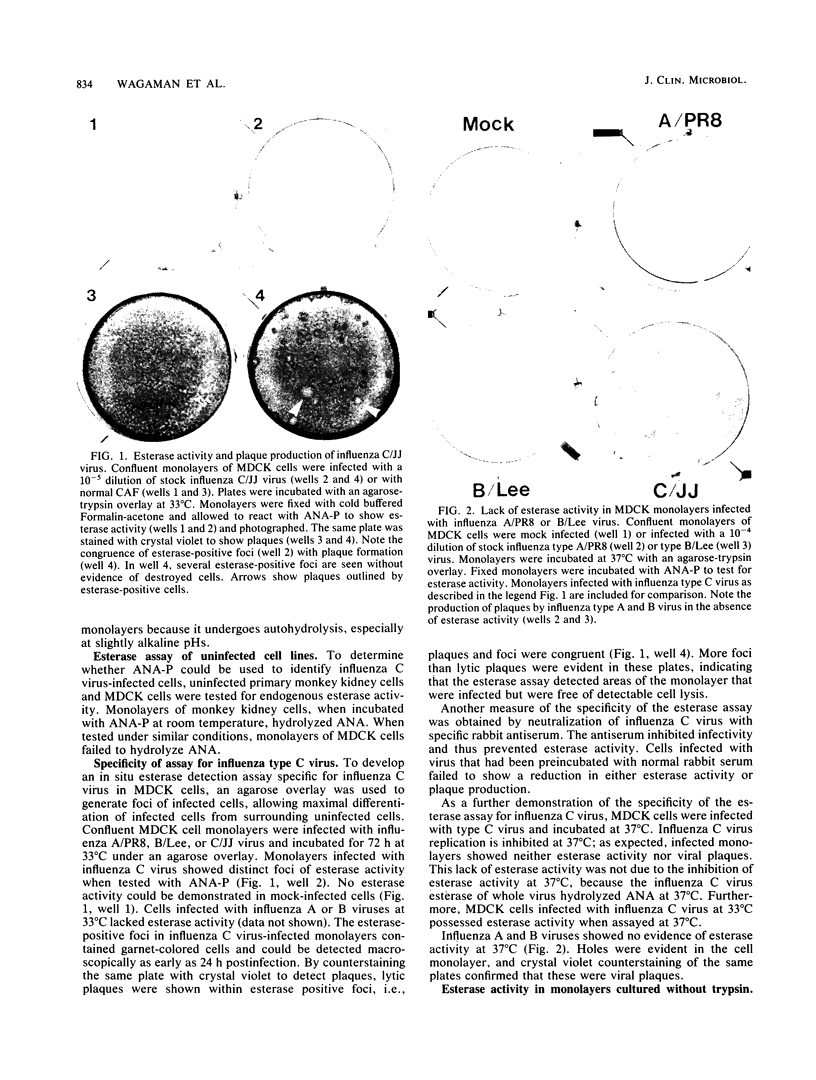

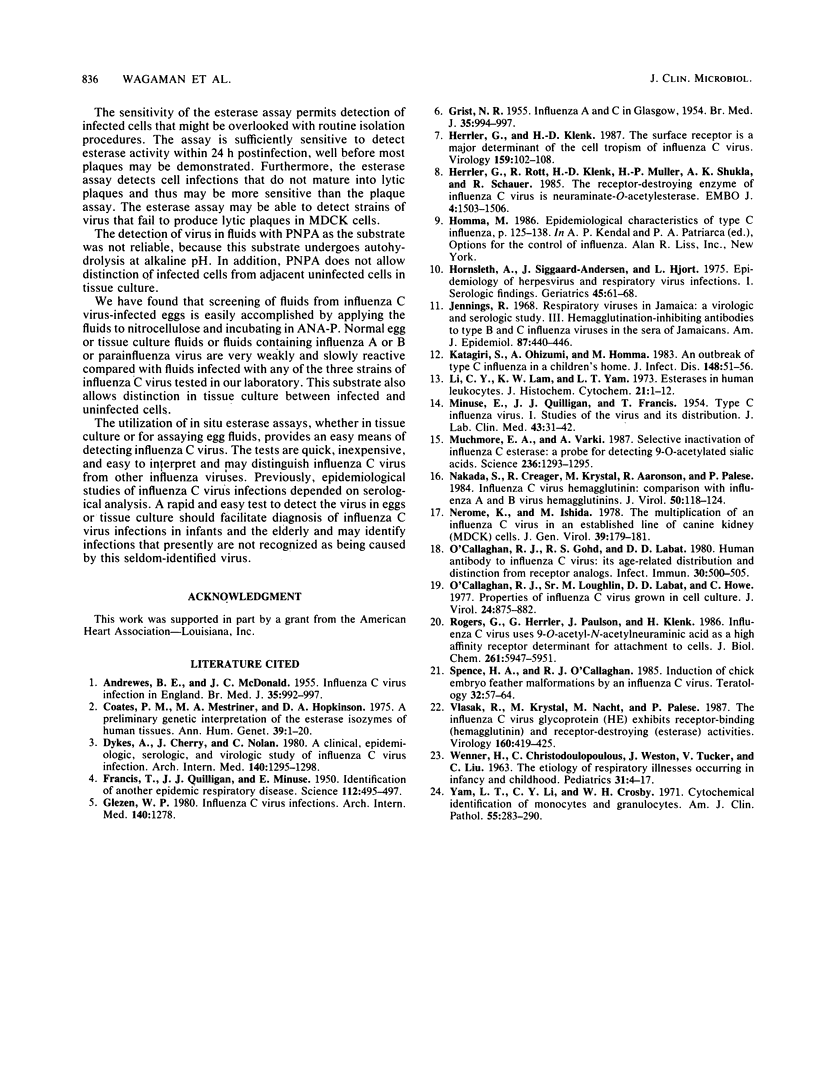
Images in this article
Selected References
These references are in PubMed. This may not be the complete list of references from this article.
- ANDREWS B. E., MCDONALD J. C. Influenza virus C infection in England. Br Med J. 1955 Oct 22;2(4946):992–994. doi: 10.1136/bmj.2.4946.992. [DOI] [PMC free article] [PubMed] [Google Scholar]
- Coates P. M., Mestriner M. A., Hopkinson D. A. A preliminary genetic interpretation of the esterase isozymes of human tissues. Ann Hum Genet. 1975 Jul;39(1):1–20. doi: 10.1111/j.1469-1809.1975.tb00103.x. [DOI] [PubMed] [Google Scholar]
- Dykes A. C., Cherry J. D., Nolan C. E. A clinical, epidemiologic, serologic, and virologic study of influenza C virus infection. Arch Intern Med. 1980 Oct;140(10):1295–1298. [PubMed] [Google Scholar]
- FRANCIS T., Jr, QUILLIGAN J. J., Jr, MINUSE E. Identification of another epidemic respiratory disease. Science. 1950 Oct 27;112(2913):495–497. doi: 10.1126/science.112.2913.495. [DOI] [PubMed] [Google Scholar]
- GRIST N. R. Influenza A and C in Glasgow, 1954. Br Med J. 1955 Oct 22;2(4946):994–997. doi: 10.1136/bmj.2.4946.994. [DOI] [PMC free article] [PubMed] [Google Scholar]
- Glezen W. P. Influenza C virus infection. Arch Intern Med. 1980 Oct;140(10):1278–1278. [PubMed] [Google Scholar]
- Herrler G., Klenk H. D. The surface receptor is a major determinant of the cell tropism of influenza C virus. Virology. 1987 Jul;159(1):102–108. doi: 10.1016/0042-6822(87)90352-7. [DOI] [PubMed] [Google Scholar]
- Herrler G., Rott R., Klenk H. D., Müller H. P., Shukla A. K., Schauer R. The receptor-destroying enzyme of influenza C virus is neuraminate-O-acetylesterase. EMBO J. 1985 Jun;4(6):1503–1506. doi: 10.1002/j.1460-2075.1985.tb03809.x. [DOI] [PMC free article] [PubMed] [Google Scholar]
- Hornsleth A., Siggaard-Andersen J., Hjort L. Epidemiology of herpesvirus and respiratory virus infections. Part 1. Serologic findings. Geriatrics. 1975 Aug;30(8):61–68. [PubMed] [Google Scholar]
- Jennings R. Respiratory viruses in Jamaica: a virologic and serologic study. 3. Hemagglutination-inhibiting antibodies to type B and C influenza viruses in the sera of Jamaicans. Am J Epidemiol. 1968 Mar;87(2):440–446. doi: 10.1093/oxfordjournals.aje.a120834. [DOI] [PubMed] [Google Scholar]
- Katagiri S., Ohizumi A., Homma M. An outbreak of type C influenza in a children's home. J Infect Dis. 1983 Jul;148(1):51–56. doi: 10.1093/infdis/148.1.51. [DOI] [PubMed] [Google Scholar]
- Li C. Y., Lam K. W., Yam L. T. Esterases in human leukocytes. J Histochem Cytochem. 1973 Jan;21(1):1–12. doi: 10.1177/21.1.1. [DOI] [PubMed] [Google Scholar]
- MINUSE E., QUILLIGAN J. J., Jr, FRANCIS T., Jr Type C influenza virus. I. Studies of the virus and its distribution. J Lab Clin Med. 1954 Jan;43(1):31–42. [PubMed] [Google Scholar]
- Muchmore E. A., Varki A. Selective inactivation of influenza C esterase: a probe for detecting 9-O-acetylated sialic acids. Science. 1987 Jun 5;236(4806):1293–1295. doi: 10.1126/science.3589663. [DOI] [PubMed] [Google Scholar]
- Nakada S., Creager R. S., Krystal M., Aaronson R. P., Palese P. Influenza C virus hemagglutinin: comparison with influenza A and B virus hemagglutinins. J Virol. 1984 Apr;50(1):118–124. doi: 10.1128/jvi.50.1.118-124.1984. [DOI] [PMC free article] [PubMed] [Google Scholar]
- Nerome K., Ishida M. The multiplication of an influenza C virus in an established line of canine kidney (MDCK) cells. J Gen Virol. 1978 Apr;39(1):179–181. doi: 10.1099/0022-1317-39-1-179. [DOI] [PubMed] [Google Scholar]
- O'Callaghan R. J., Gohd R. S., Labat D. D. Human antibody to influenza C virus: its age-related distribution and distinction from receptor analogs. Infect Immun. 1980 Nov;30(2):500–505. doi: 10.1128/iai.30.2.500-505.1980. [DOI] [PMC free article] [PubMed] [Google Scholar]
- O'Callaghan R. J., Loughlin M., Labat D. D., Howe C. Properties of influenza C virus grown in cell culture. J Virol. 1977 Dec;24(3):875–882. doi: 10.1128/jvi.24.3.875-882.1977. [DOI] [PMC free article] [PubMed] [Google Scholar]
- Rogers G. N., Herrler G., Paulson J. C., Klenk H. D. Influenza C virus uses 9-O-acetyl-N-acetylneuraminic acid as a high affinity receptor determinant for attachment to cells. J Biol Chem. 1986 May 5;261(13):5947–5951. [PubMed] [Google Scholar]
- Spence H. A., O'Callaghan R. J. Induction of chick embryo feather malformations by an influenza C virus. Teratology. 1985 Aug;32(1):57–64. doi: 10.1002/tera.1420320109. [DOI] [PubMed] [Google Scholar]
- Vlasak R., Krystal M., Nacht M., Palese P. The influenza C virus glycoprotein (HE) exhibits receptor-binding (hemagglutinin) and receptor-destroying (esterase) activities. Virology. 1987 Oct;160(2):419–425. doi: 10.1016/0042-6822(87)90013-4. [DOI] [PubMed] [Google Scholar]
- Yam L. T., Li C. Y., Crosby W. H. Cytochemical identification of monocytes and granulocytes. Am J Clin Pathol. 1971 Mar;55(3):283–290. doi: 10.1093/ajcp/55.3.283. [DOI] [PubMed] [Google Scholar]




